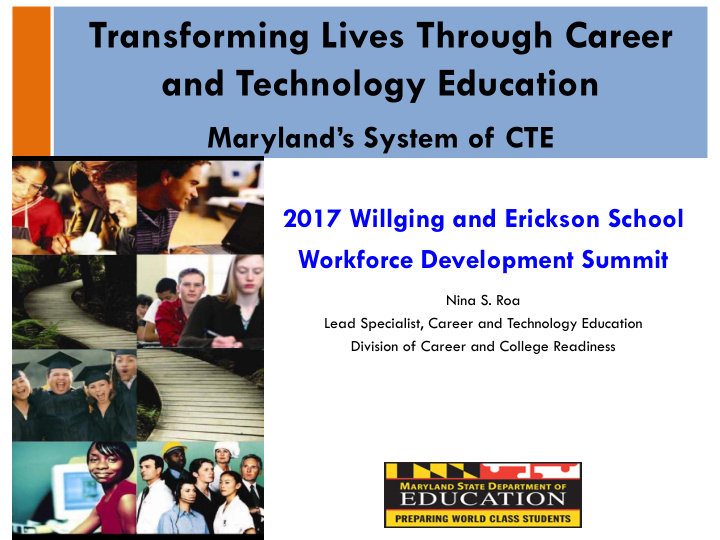



Transforming Lives Through Career and Technology Education Maryland’s System of CTE 2017 Willging and Erickson School Workforce Development Summit Nina S. Roa Lead Specialist, Career and Technology Education Division of Career and College Readiness
A ¡Key ¡Component ¡of ¡the ¡ High ¡School ¡Experience 2
10 CTE Career Clusters • Arts, Media, & Communication • Business, Management & Finance • Construction & Development • Consumer Services, Hospitality, & Tourism • Environmental, Agricultural, & Natural Resources Systems • Health & Biosciences • Human Resource Services • Information Technology • Manufacturing, Engineering & Technology • Transportation Technologies MDCTEPROGRAMS.ORG 3
CTE: High Quality Pathways Leading to Career & College Readiness • Programs must include a sequence of courses (at ü ü least 4 credits) leading to advanced career entry and further study. • All programs must be state-approved. Local ü ü school systems adopt/develop and administer programs in partnership with community colleges and industry/business. • Federal funding is used for new program ü ü development, improvements, and professional development. 4
CTE Programs in the Health and Bioscience Cluster • Project Lead The Way (PLTW) Biomedical Sciences – Nationally recognized STEM program – Four (4) course sequence, culminating with an in-depth research project – Focused on preparing students to be successful in science, engineering and biotechnology programs at the four and two year college levels – 20 out of MD’s 24 school systems offer the BMS program in 50 high schools; as of 2016 3,804 students enrolled; growing enrollment – Transcripted college credit through Stevenson University • Academy of Health Professions – Two core courses and then choose from multiple specialty courses that prepare students for industry certifications (e.g. CNA/GNA, CCMA, Pharm Tech) – 22 out of MD’s 24 school systems offer the AHP program in 45 high schools; as of 2016 3,336 students enrolled; growing enrollment – Transcripted credit through Stevenson University 5
P-20 System of Education Every step along the pathway is crucial to making each student’s future a success Employment: Career Advancement Continuing education and lifelong learning Post-secondary: Career Preparation Achieving credentials: college, certifications, apprenticeships, military 9–12: Career Preparation Participating in academic and technical courses with guidance on graduation plans 8: Transition Choosing a program of study and a career major (can change as a student matures) 6–8: Career Exploration Discovering interest areas, identifying an educational path aligned with interests K–5: Career Awareness Learning about the world of careers and the ways in which people make a living 6
Quick Facts About Maryland CTE - 2016 • 98,857 or more than one third (38.7%) of all high school students enrolled in 148 CTE programs in 237 high schools • 22.8% of the class of 2016 completed a CTE program of study (13,258) • 58% of the CTE graduates also completed the coursework for entrance to USM, this is a “Dual Completer” (7,703) 7
Academy of Health Professions: CNA/GNA Preparation • CNA/GNA is as specialty course within the Academy of Health Professions Career and Technology Education program of study • 33 high schools are approved to offer the CNA content – MD Board of Nursing must approve the CNA/GNA portion of the program • 20 of those high schools also prepare students for GNA – Almost 400 students sat for the GNA exam; 90% passed 8
English ¡9 English ¡10 English ¡11 English ¡12 English ¡-‑ 4 AP ¡Language AP ¡Literature World ¡History US ¡History Government Social ¡Studies ¡-‑ 3 Us ¡Govt. AP ¡European AP ¡US ¡History AP ¡Government Trigonometry ¡or Mathematics ¡-‑ 3 Algebra ¡I Geometry Algebra ¡II Pre-‑Calculus ¡or Calculus ¡or Required ¡each ¡year AP ¡Calculus Biology ¡or Chemistry ¡or Physics ¡or Science ¡-‑ 3 Earth ¡or ¡Physical ¡ Sci. AP ¡Biology AP ¡Chemistry AP ¡Physics Phys ¡Ed. ¡-‑ .5/ ¡Health ¡Ed. ¡ .5 ¡Phys ¡Ed. .5 ¡Health -‑ .5 Fine ¡Arts ¡-‑ 1 .5 ¡Fine ¡Arts .5 ¡Fine ¡Arts Tech ¡Ed ¡-‑ 1 Intro ¡to ¡Eng. ¡ Design CTE ¡Program ¡Sequence CTE ¡Completer-‑ 4 Foundations ¡of ¡ Structure ¡and ¡ CAN ¡Theory ¡and ¡ Medicine ¡and ¡Health ¡ ¡ Functions ¡of ¡the ¡ Practical) ¡(2) ¡ (1) Human ¡Body ¡(1) Foreign ¡Lang. ¡– 2 ¡ Language Language Advanced ¡ Advanced ¡Technology ¡ 9 or Technology ¡ Education Adv. ¡Tech ¡Ed. ¡-‑ 2 ¡ Education
Benefits to the Academy of Health Professions CNA/GNA Pathway • CTE and College Prep Academic Curriculum – Graduate with industry certifications and college credit • Work-Based Learning Experiences/Mentorships/Internships/Clinical experiences • Leadership and employability skills – CTE Student Organizations • Standardized/scalable program design and delivery (student mobility issues) • Industry partnership support for program implementation and improvement – Local program advisory committees • Funding support from MSDE – Federal Perkins funds to support teacher professional development and program improvement and expansion . • Statewide professional development opportunities/professional learning communities 10
Challenges to the Academy of Health Professions CNA/GNA Pathway • Recruitment and retention of teachers – For CNA/GNA teaches must possess an RN – Must also become a certified MD teachers • External restrictions on program – 8:1 student teacher ratio for CNA clinical rotations • Finding clinical partners for high school programs • Costs for assessments leading to industry certifications (e.g. background checks) • Expanding professional school counselors’ knowledge of career options in today’s global economy • Lack of parent understanding of CTE (Social Media Campaign) 11
Employer ¡Involvement • State ¡Advisory ¡Groups • Career ¡Technology ¡Student ¡Organizations – SkillsUSA – FFA – FBLA ¡(Future ¡Business ¡Leaders ¡of ¡America) – DECA • Program ¡Advisory ¡Committees
Questions? Nina S. Roa Lead Specialist, Career and Technology Education Division of Career and College Readiness Maryland State Department of Education nina.roa@maryland.gov 410-767-1904
Recommend
More recommend